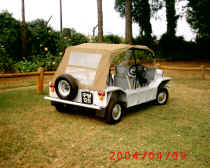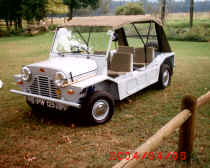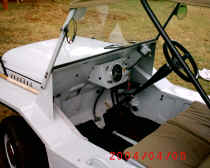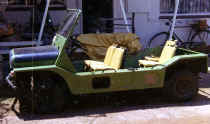|
What is a 'Moke' ? Apart from the name given to these nifty, Mini car based, Jeep like, vehicles from the 60's and 70's, its a British English slang term for a working Donkey. |
||
|
| |
||
|
"Special Delivery" Moke by Air The Aircraft marking is 'RRAF' or 'Royal Rhodesian Air Force' |
||
|
About 300 MkI Mokes where known to have been produced by the BMC Plant in the then city of Umtali in Rhodesia a few have survived including Body number 001. Body number 281 is with the author and a few others are recorded as still being in Zimbabwe. Most of the surviving vehicles are badged BMC, with "Morris" Engines.
Although the majority of parts in the knock down kits (CDK's) sent from the BMC factory in England to the Plant in Umtali are dated 1964, (ie early production Moke Mk1's) the first assembled Mokes from Umtali most likely where assembled in '65 and as late as 1967.
The article at: http://www.ourstory.com/thread.html?t=364725#451329 shows CMED Moke No. 52 being unloaded from a Dakota / C47 aircraft at the Bulawayo Trade Fair in 1965 (see pics above). This photo partly answers the question as to what colour the Umtali Mokes left the Plant, which appears to be the standard "Spruce Green" (British Standard Colour; 381C 248) of British Mk1 Mokes. It would seem the Police Mokes where only later painted in 'CMED' Grey for Police service. (Assumed to be: British Standard Colour 381C 626 camouflage gray)
If you should know of any surviving Umtali made Mokes, please contact the author at; moke(@)baragwanath(.)co(.)za.
The gray Moke depicted below is one of the first 100 Mokes produced and taken into service by the then Rhodesian 'Central Mechanical Equipment Depot' or CMED and issued to the Rhodesian Police Force ("British South Africa Police" or BSAP) for primarily rural policing duties. (The Mini sedan was used for town policing, in particular, traffic duties).
CMED vehicle markings or registrations were comprised as follows: G over T for 'government transport', 'PW' as an identifier for the class or type of vehicle unique to the vehicle. Ordinarily, these letters would directly identify the vehicle such as LPD for Leopard, but for some reason the Moke was designated Pee Wee. The number that then followed was the 'count' of the particular vehicle. (ie No's 52 and 125 of the government Moke fleet).
Surviving African Mokes are recorded at:
- Micke Pettessons African Moke: An African Moke in Sweden. - Moke body number 210, located at; FERNMIN - the Mini specialists in Johannesburg. - Moke body number 315, recently identified in Harare. This vehicle is extremely interesting in that, not only is it numbered above 300, this being the generally accepted number produced, the Engine is badged "Austin", the first example known, but most likely had an Engine change. - Moke No 1, believed to still be in Zimbabwe. (Technically this is Moke 'Zero' being the vehicle sent out for trials and as a pattern). - Moke No 14, recently identified in Bulawayo. - Moke 224, recently identified in Pretoria. (With 998cc Engine). - Unknown number identified on a Tea Estate in Malawi. (with 998cc Engine).
- Authentic, hand made, faithful reproduction Hoods and Bows for the British MkI and Rhodie Moke. |
||
|
| |
||
|
Body numbers 36 (background) and 281, circa 2006 |
||
|
Manufacturers plates from 281 |
||
|
Mauseth Moke, Body number not known. (The front bumper is bent !) |
||
|
| |
||








